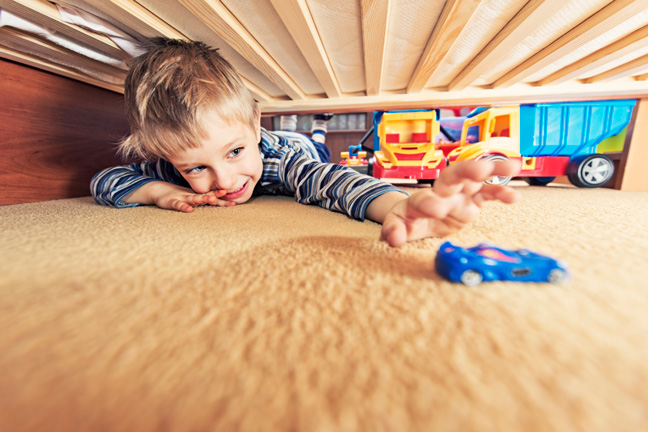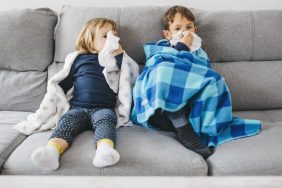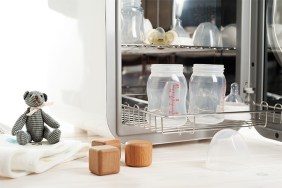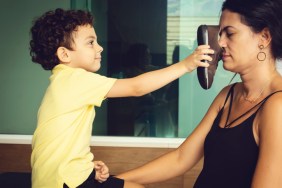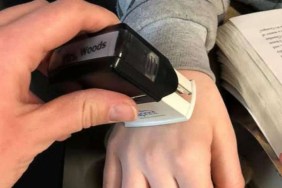I think the moment I became a mom I also became a germaphobe. I was constantly hand washing, I kept antibacterial gel within arm’s reach for anyone coming in contact with my first son, and I tried to make sure our home stayed clean and germ-free. In my paranoia, I had discovered all kinds of strange places that germs lurked that I never gave a second thought to before. But by the time I had a second baby (and now a third), I realized all that germ-worrying took a lot of energy and that it was nearly impossible to protect my kids from all of the germs unless I wanted them to live in a bubble. Plus, letting my kids get exposed to some germs is actually good and helps their immune systems to get stronger by building immunities.
My germ-defense strategy has evolved from anxiety over my baby catching even the littlest case of the sniffles to wanting to protect my children from the nastiest germs and viruses by attacking them where they hide. I focus my energy and efforts on the germy places my kids touch daily.
Restaurant Condiment Bottles
What kid isn’t reaching for the condiment bottles on restaurant tables every time you go out to eat? Between entertainment and “doing it themselves,” little fingers are sure to find the ketchup bottle. But think about it: Most restaurants don’t disinfect condiment bottles (especially not between customers), and many people don’t wash their hands before eating. The high turnover in restaurants means lots of grimy hands touch those bottles, making that surface a popular spot for bacteria and germs.
Solution: Use a disinfecting wipe or hand sanitizer to wipe down the ketchup bottle before your family uses it. (Using a napkin isn’t enough.)
Washing Machine/Clean Laundry
You probably think your freshly washed clothes are, well, clean. But most germs are killed in the dryer. If you think about what you wash in your washing machine (anyone have a baby? Think of the blowouts alone!), keep in mind that those germs are still inside your washer and on the clothes coming out of it. So if you have a child transfer clothes from the washer to the dryer, or you air dry something they wear—or if you are doing the transferring and not washing your hands after—you are possibly contaminating other surfaces.
Solution: Wash your hands after moving clothing from washer to dryer. Also, when washing the dirtiest offenders, use a sanitizing cycle if possible.
The Toothbrush Holder
While we probably all think the toilet is the nastiest place in the bathroom, the reality is that the toothbrush holder is actually the germiest. When left out on the sink or vanity, toothbrush holders are exposed to fecal bacteria from toilet flushing due to their proximity to the toilet. And when the toothbrushes aren’t rinsed properly, the bacteria from your mouth can travel down into the base of the holder, exposing one child’s toothbrush to another child’s germs.
Solution: Keep toothbrushes in a medicine cabinet or at least five feet away from any toilet. Eliminate the community toothbrush holder if you can or wash regularly by hand with hot soapy water, or in the dishwasher if they are dishwasher safe.
Kitchen Sponge
You probably think of the kitchen sponge as something to help you keep things clean, but it is actually the germiest thing in most households. Because they pick up germs in the cleaning process and usually aren’t properly sanitized before their next use, they tend to be the biggest contaminant. If your little one likes to “help” you clean up and use the kitchen sponge or dishrag, they are likely getting exposed to bacteria and germs in the process.
Solution: Sanitize or wash sponges and dishrags after each use. Allow them to dry thoroughly. Make sure to have your kids wash their hands after they help you clean up. And stick to paper towels or disinfecting wipes for cleaning counter tops and surfaces.
Cell Phone
Before you hand your kid your cell phone to give yourself a minute of peace or sanity, know this: Your cell phone is in the top ten for worst germ hot spots. And if you have a case, shield, or cover on it (and if you have kids, you know you do), there are even more places for germs to hide.
Solution: Use a disinfecting wipe to thoroughly clean your cell phone and case at least every couple of days. And be mindful of where you rest your device when it isn’t on your person or in use.
The Family Pet
Yep, if your home has a treasured family pet, you might be surprised to learn that pet bowls and toys are some of the germiest places in your house. If your kids touch these, they can pick up germs and bacteria. Just think of all of those crawling toddlers that won’t leave the dog dish alone or your little ones playing with the dog toys. And if they do pick up germs they can contaminate other areas.
Solution: Cleaning dog bowls and toys regularly with a vinegar soak or a run through the dishwasher can help, as can teaching your children good hand-washing practices (or washing for them in the littlest cases).
Kitchen Sink
This one might be obvious to you, but since it is a common place that kids and their food are near, it is worth mentioning. The kitchen sink is the dirtiest place in your home. Like, way way way dirtier than your toilet. So before your kids wash their hands at the kitchen sink or you serve them that strawberry that you dropped in the sink but rinsed off, keep that in mind.
Solution: Be sure to disinfect your sink frequently, especially areas like the faucet handle and drain. And, of course, maintain good hand washing practices.
Floor
I’m one of those crazy “take your shoes off the second you step inside the house” kind of moms. And for good reason! Think about where you walk. And think about what you step in that you don’t even realize. Most shoes have bacteria containing fecal matter on the soles.
Solution: Be the crazy “take your shoes off the second you step inside the house” mom. Instituting a shoes-off policy for all visitors helps tremendously. Keep the welcome mat outside of your entry door instead of inside if possible (germs collect there, too). And disinfect doormats weekly.
Car Seats
Blowouts, snotty noses, food, and dirty hands—everything gross touches your kid’s car seat. And then your kid does.
Solution: Give the seat a good cleaning if you’ve already been using it, wash the cover any time there is a diaper leak, and once it is clean use hand sanitizer before getting in the car. I keep a pump bottle in the cup holder of my minivan, and we pass it around and clean hands at school pickup, after a trip to Target, when we are leaving the playground, etc. to get rid of any germs that are hitchhiking home with us.
Soap Dispenser
All of that good hand washing means the kids are touching the soap dispenser multiple times a day. But soap bottles and bars are not self-cleaning. They often collect germs because we forget to clean those areas, and hands are constantly touching them.
Solution: Wash hands thoroughly in hot water for fifteen to twenty seconds (I tell my kids to sing the ABC song and wash for the entire song). Use liquid soap instead of bar soap. And don’t forget to disinfect the soap pump regularly. When washing your hands in public restrooms, it doesn’t hurt to disinfect with antibacterial hand sanitizer afterward to be safe.
Hand Towels
Shared hand towels in the kitchen and bathroom tend to be used by many hands and stay moist, which creates a breeding ground for bacteria. So if your family shares a hand towel, they are likely sharing germs, too.
Solution: Frequently wash hand towels (between uses is best but not necessarily doable) on the sanitizing cycle. I buy a bunch of white hand towels at IKEA, change them out frequently, and wash with bleach on the sanitizing cycle.
Photo: Getty/Imgorthand
